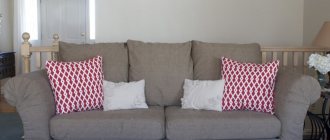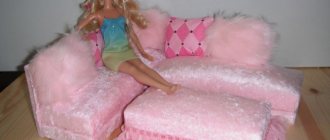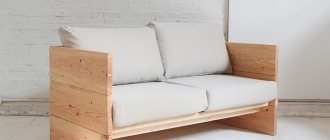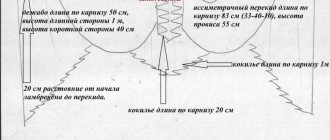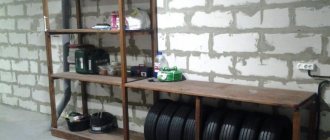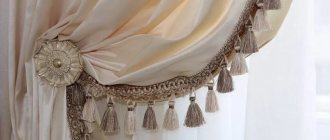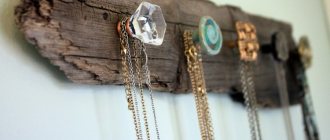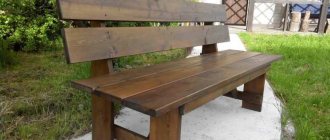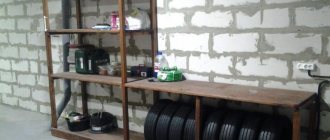Upholstered furniture is an expensive thing. Therefore, it is not surprising that there is a desire to preserve its purity, novelty and beauty for as long as possible. The optimal solution is to sew a cover. However, it can be used not only to protect a new purchase from dirt and damage, but also to improve old furniture.
In addition to purely functional purposes, covers play the role of decorative elements, helping to fit sofas and armchairs into the overall style of the interior.
Advantages of a hand-sewn sofa cover
DIY sofa covers have the following advantages:
- relatively low cost;
- ease of use;
- ease of washing;
- the ability to bring furniture into line with the overall style of the interior;
- aesthetics;
- uniqueness.
By making several different models, you can experiment with the appearance of a piece of furniture. At the same time, such needlework requires very little time.
What fabric should I use to make a sofa cover?
It is worth taking the choice of fabric seriously. Any type of material will work the first time. For anyone, a sofa cover should be practical and durable.
It is not recommended to use two extremes - too heavy and dense upholstery fabric, which is used for the manufacture of upholstered furniture, too light, does not hold its shape well, and thin, which requires additional processing.
Lightweight fabrics include chiffon, rayon and satin. Capes made from these fabrics look incredibly beautiful, but they will not last long and will quickly lose their attractive appearance. It is still better to use such materials for sewing clothes and accessories.
Many people believe that upholstery fabric will be an ideal option for sewing a cover, because it is used to create sofas, armchairs and corners. But please note that the upholstery is tightly fastened to the frame using a stapler and small nails. This means that such material is completely inelastic. You simply cannot physically tighten its back and armrests. Who should not forget that the cover must be removed periodically in order to wash it.
That is why it is best to choose the golden mean - moderately dense, moderately soft and elastic material. Ideally, it should be impregnated with a special product. Waterproof material will allow the furniture to remain fresh and clean for a long time.
If you don’t want to specifically buy fabric to make a cover, you can use improvised materials. We present the options for what material the cape can be made from:
- eco-leather;
- izplad;
- from the bedspread;
- from jeans and many other things.
With a little effort and imagination, you can even make a beautiful sofa cover out of old clothes.
The sofa cover can be decorated in various ways. The lower part can be ruffled. Embroidered ribbon will also look beautiful. A cape created in patchwork style will look interesting. To create it you will need scraps of a wide variety of fabric.
Design nuances
As you can see in the photo of a hand-sewn sofa cover, it usually consists of several rectangular elements that should completely cover the surface of the upholstery.
The role of the retainer is traditionally performed by elastic bands, cords or braid. To add elegance and sophistication, details such as frills and ribbons tied into bows are used.
On the Internet you can easily find a large assortment of patterns for sewing a sofa cover with your own hands.
Therefore, if you decide to start sewing such “protection” of furniture yourself, you will not have problems choosing a suitable pattern.
How to sew a corner of a sofa cover?
If you have purchased upholstered furniture with expensive and beautiful upholstery, it is clear that you do not want to hide it under various blankets and blankets. Nezyryazhe spent hours choosing the shade of upholstery and texture that matched the pile of the carpet and curtains!
In such cases, you want to protect only the most sensitive and most dirty parts. You can easily make separate covers for the armrests, pillow, sides or seat. In addition, you can make compact pockets for remote controls, which is very practical and convenient.
If a common cover holds all parts of the sofa cover, then the armrests can fly off very quickly. When creating them, it is necessary to consider an autonomous mount. Linens, elastic bands or ribbons, bows or laces are perfect. They will look beautiful. You can also use snaps or Velcro. But it is better to sew them on the bottom of the armrest so that they do not interfere. Otherwise, you will have to change them often or they will ruin your clothes.
This is very convenient, because you can make several capes at once. They are easy to change when washing, and they will also help update the design of the sofa and make it more interesting when it starts to wear out. They can be matched to pillowcases, pillows or other elements of the room.
Source: 1000sovetov.ru
Material selection
There are a number of requirements for the fabric for a cover. First of all, it is strength, wear resistance, and ease of maintenance.
The following items answer these requests:
- jacquard;
- flock;
- shinil;
- artificial and natural leather;
- microfiber;
- artificial and natural fur.
Announcements on NN.RU – Handicrafts
Portrait - For a teacher, educator, official - a unique and unforgettable gift Price: 5,000 rubles.
A romantic walk, like in the good old aristocratic times. Ride a horse, what pleasure can compare with. Price: 3,000 rub.
I will paint a portrait in any genre on a box of any size Price: 6,000 rubles.
If you still don't have any favorite photos, then perhaps you've been waiting for winter! An incredible backdrop of snow-covered expanses and bright winter sun. Price: 2,000 rub.
Source: www.nn.ru
Required tools and accessories
Such needlework requires the use of the following things:
Note!
How to make wooden shelves with your own hands - original design options
Kinusaiga technique for beginners: what is it, a description of creating paintings from threads
How to weave a figurine from rubber bands: how to learn to weave animals, toys and what you can make from rubber bands on a slingshot
- overlock;
- measuring tape;
- pins;
- scissors;
- thread of the corresponding color.
The craftswoman also requires accuracy and patience.
A few useful things
Some tips will help minimize the risk of annoying interference and errors, which can sometimes ruin all your efforts.
- When transferring patterns to fabric, under no circumstances should you skimp on allowances. Excess material is easy to remove, but not enough will be catastrophic.
- When working with dense fabric, you cannot use a small stitch width. The optimal step is 1.5-2 mm and two seams. Otherwise, the fabric is easy to damage.
- A loose cover is a lesser evil, since the excess quite easily becomes less noticeable if you tighten it with elastic bands stitched into the seams.
- If a cover is required to protect a leather sofa, then even a cover made of durable fabric requires additional foam padding to prevent the material from slipping and claws.
- The “hem” of the cover is too wide - a defect that can be eliminated with a drawstring through which a simple linen elastic is threaded.
- Those who master knitting needles can knit individual parts, and then just carefully sew them together.
- A tight product is worse than a loose one, since constant tension does not contribute to durability.
Sequence of actions when sewing a cover
Here are the standard instructions for “sewing sofa covers with your own hands”:
- Take the necessary measurements of the armrests, backrest, and seat.
- Create a pattern and calculate how much fabric you will need. Don't forget to take seam allowances into account.
- Transfer all the details from the paper to the material and cut it out.
- Connect the elements together using a stitch. Try on the product. Adjust it to the dimensions of the furniture.
- After adjustments, remove excess fabric, leaving only seam allowances. Overcast and sew the edges using an overlocker.
- Wash the finished product in warm water and iron.
- turn it inside out and use chalk to mark the line of the elastic band;
- fix the elastic along the markings using pins;
- sew on a sewing machine, selecting a three-step seam in its settings.
How to sew a sofa cover yourself?
In order to make a sofa cover yourself, it is enough to use the skills of working with a sewing thread and a needle. A sewing machine will be an excellent assistant. But most of the work still needs to be done manually. Pattern making skills will also come in handy. After all, you need to make it yourself individually for your sofa.
But here you can cheat. A very simple and easy way is to use an old cape that may have been lying around in the closet. It must be cut into separate pieces and transferred to new material.
An old cape can be found in almost every home. Fortunately, there are many master classes on the Internet that offer various methods and options on how to properly make a sofa cover. They provide step-by-step instructions that will simplify the creation of the pattern.
Decoration
You can decorate the finished case with the following things:
- frills;
- bows;
- ribbons;
- stripes;
- applique.
It is appropriate to decorate the armrests with a decorative cord. And to focus attention on the lower part of the product, it is optimal to use a wide braid.
Covers can be used not only to preserve the newness of purchased furniture, but also to enhance old ones.
In addition, they also serve as interior decoration. Even a novice needlewoman can handle sewing them. The main thing is to have desire, imagination and patience.Is it possible to knit
A sofa cover can also be knitted using knitting needles.
You can knit a blanket either by knitting or crocheting.
But it is worth considering some nuances:
- when crocheting, the fabric turns out to be coarser and denser, and when using knitting needles, it becomes soft and elastic;
- hooks are indispensable when creating appliqués and flat patterns; the use of knitting needles is ideal for knitting relief patterns;
- if you want to get a double-sided fabric, then use hooks, since a knitted item will definitely have a front and back side;
- if you make a mistake in knitting, you will have to unravel most of the fabric, while when crocheting, the process can be continued from anywhere.
Any needlewoman can knit such a thing as a cape on her own.
Photo of do-it-yourself sofa covers
Note!
How to properly make a birdhouse with your own hands from scrap materials: we create an original birdhouse according to sketches
How to make candles with your own hands: instructions for making wax, gel, scented, homemade decorative candles with a wick
What you can make from foamiran with your own hands: we create flowers, Christmas tree decorations, snowflakes, three-dimensional paintings (photo + video)
Please repost
0
Rules for caring for a bedspread or blanket
Recommendations for caring for blankets vary significantly depending on what material the product is made of. Before sewing a cover, you should familiarize yourself with the washing rules of the selected fabric and make sure that it will be easy to clean. In this sense, products made from scraps pose a certain problem, since different materials, pieces of which can be used in their manufacture, will require different care.
Tapestries, faux fur, jacquard, and pile fabrics can be vacuumed periodically. These materials collect dust, so they need to be cleaned regularly. Most synthetic materials can be machine washed on a delicate cycle and spin at low speed. Natural wool with the addition of artificial fibers is also machine washable. The product should be dried in a well-ventilated area away from heating devices.
It is not always possible to clean such products at home due to their size. In such cases, it is better to take it to the dry cleaner. Proper care of the bedspread will ensure its safety and beautiful appearance.

